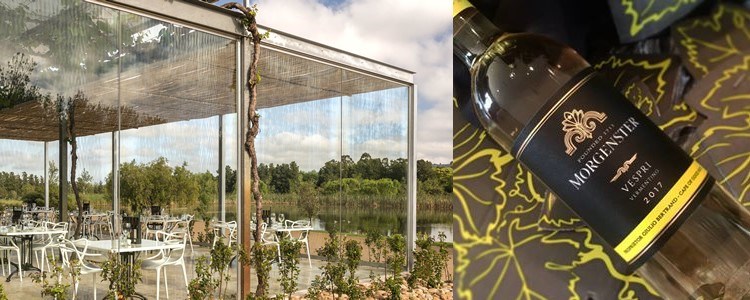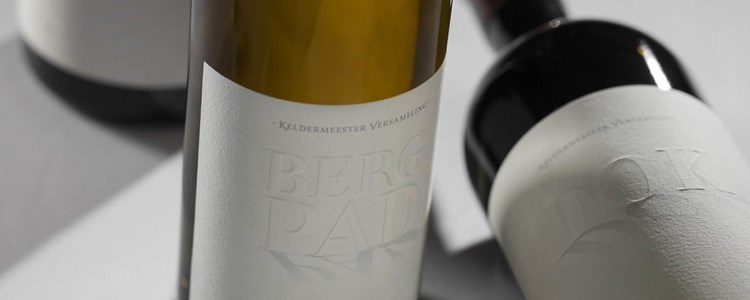At the last tasting of 2018, I stared into a deep trench in a prized Grenache Noir vineyard at Waterford Estate in Stellenbosch. Winemaker Mark le Roux says his crew have dug four deep holes in every bloc on the farm to learn more about water stress and irrigation. The age of vines are a major factor in drought viticulture - and the deeper the roots, the better the water retention. The Grenache vines are considered young at twelve years, but the diversity of soils express the Mediterranean side of Waterford - and encourage experimentation with drought-resistant varieties from Barbera, Grenache Blanc and Sangiovese to Grenache, Mourvedre and Tempranillo.
Tasting a single varietal Grenache Noir in situ in a spectacular landscape with a ridgeback called Grenache is a great way to appreciate the terroir of a wine farm. We also tasted Waterford’s benchmark Chardonnay 2015 in a bloc planted in 1988 - one of the oldest single Chardonnay vineyards in the Cape. Cellar master Kevin Arnold calls it “one of the jewels of the South African Chardonnay project”. But he adds, “Our goal is to make one wine which represents the entire farm” - the flagship called The Jem made from eight French, Spanish and Italian varieties planted at Waterford.

Waterford Estate - The Jem
Back in the cellar we enjoyed a tasting of vertical flights of alternate varieties such as Grenache Blanc, Grenache Noir and The Jem - one of the country’s best-selling and highest-volume super premium wines on export and domestic markets. Mark le Roux comments, “With the heat and the drought, we find the alcohol levels across our wines are actually getting lower - but we get the same phenolic ripeness - and we use much less new wood”. Kevin Arnold adds “Cabernet Sauvignon is our focus variety - for Waterford, The Jem and Stellenbosch. We’re planning major tastings to build the Stellenbosch Cabernet Sauvignon brand in 2018, building up to Cape Wine 2018”.
Exciting new alternate varieties are coming to the fore with a wide range of new releases in late 2018. At a recent tasting at Morgenster in the Helderberg, owner Giulio Bertrand unveiled the fourth wine in the farm’s opera-themed Italian collection which already includes Tosca (Sangiovese, Cabernet and Merlot blend), Nabucco (single varietal Nebbiolo) and Caruso Rosé (Sangiovese). At the launch of the maiden Vespri Vermentino 2017 - from a clone bought in from Sardinia - winemaker Henry Kotzé described the variety as showing “the fruit-driven character of Sauvignon Blanc, the creamy texture of Chenin Blanc and the aromatic perfume of Viognier”.
The winemaker says their vision is to make Morgenster “world leaders of South African Italian varieties. Italian varieties do very well in South African soils and a hot climate - the terroir of Piedmont and the Cape are similar in many ways. Tosca is like our own super-Tuscan Antinori blend.” They have planted more Sangiovese and Nebbiolo - a variety which expresses “a different style of fruit to any other variety planted in South Africa - unlike even an Italian Barolo”. The spicy, savoury character of Morgenster’s Italian collection - wines with ripe cherry, ripe tomato, aniseed and Mediterranean herbal character - were a superb match to Italian chef Giorgio Nava’s cellar restaurant at 95 at Morgenster, the leading Italian restaurant in the winelands.

95 at Morgenster I Morgenster Vespri 2017
While exploring unusual new varieties over the summer, I also enjoyed tasting the first commercial release of Vermentino from Ayama Wines in the Voor Perdeberg in Paarl. Back in 2014, I was privileged to join Italian owners Atillio Dalpiaz and winemaker Michela Sfilgoi when media and friends helped plant the first Vermentino vineyard in South Africa. (We also enjoyed a fabulous tasting of Vermentino from its native Sardinia The first 2016 vintage of 790 bottles was released in mid-2017 under a snazzy arty label. Michela comments, “Vermentino is a perfect match for our hot and windy terroir and long dry summers, with our clay and decomposed granite soils with low water retention. It creates powerful, aromatic white wines.” I loved the floral aromatics and Med flavours of figs, tomato, thyme and mint, the salty Sardinian tang.
My learning curve in alternate varieties continued at Bosman Family Vineyards outside Wellington. I made a stokkies draai to one of the leading vine nurseries in Africa, an old family winery with deep roots going back to 1699 - combined with new generation plant pathology and technology. On a hot day in the Boland, I understood the need to develop new, drought, heat and disease-resistant grape clones and varieties scientifically suited to global warming. On a tour of old bushvine and new vineyards, the viticulturist spoke about “the lower energy reserves of root stock during the drought” - and how they learned from working with grape growers in Italy and Spain.
Cellar master Corlea Fourie led a tasting of some of the innovative wines made from over fifty varieties planted in their nursery and vineyard in Wellington and Hemel-en-Aarde (bottled under their fairtrade De Bos export brand - like the 47 Varietal Rosé). We enjoyed the new Bosman “Fides” (meaning a Roman command to trust in grafting vines and winegrowing) Grenache Blanc - an orange white wine naturally fermented on the skins for nine months with pithy tannin and texture, floral blossom and lime character. Back on the Italian theme, I really enjoyed their maiden Nero d’Avola, a ten year-old project - a Sicilian variety which thrives in arid, hot climates - a fragrant wine (best chilled) with charming candied cherry and liquorice flavours. We finished with the sweet twist of their Dolce Primitivo, made from botrytis Zinfandel grapes.
Over the summer I also enjoyed tasting Lanzerac’s new KV (Keldermeester Versameling) range of limited release wines - especially the KV Bergpad Pinot 2016 sourced from a single bloc in the Jonkershoek Valley of Stellenbosch planted in 1993. Fermented and matured for 11 months in old oak barrels using mainly natural yeast, the wine has lingering flavours of quince and pears with a creamy texture. I also really enjoyed the limited bushvine vineyard release of Swartland Winery’s Roussanne 2015 with its trademark herbal aroma and acidity. My most exciting discovery so far in 2018 is Org de Rac Waghuis Blanc 2016, an aromatic, textured Swartland blend of Verdelho, Chenin Blanc and Rousanne - made by Jurgen Siebritz.

Lanzerac's Keldermeester Versameling
I’ll finish my journey to find new flavours in new varieties with a tasting of one of the oldest Cape grape varieties grown in one of the region’s oldest vineyards. In late 2018, owner Basil Landau and winemaker Wynand Grobler released their Landau du Val Private Selection Semillon 2014 - made from 109 year-old dryland bushvines planted on their farm high in the Franschhoek Wine Valley. This dry Semillon, a blend of Semillon and Semillon Gris (from a natural mutation in the block), is whole-bunch pressed and left on the skins to naturally ferment and extract the flavour in old barrels. Wynand says “It’s the chance of a lifetime for a winemaker to work with these vines. I don’t have to do much in the vineyard. We get awesome acidity, a low ph and great minerality. These old vineyards actually produce higher yields in drought years, increasing to ten tons in 2017. The style is fresh, taunt, mineral and zesty”. We tasted it over a superb menu created by chef Chris Erasmus at Foliage in Franschhoek. Global warming, climate change and drought sure make for thirsty times and vines.